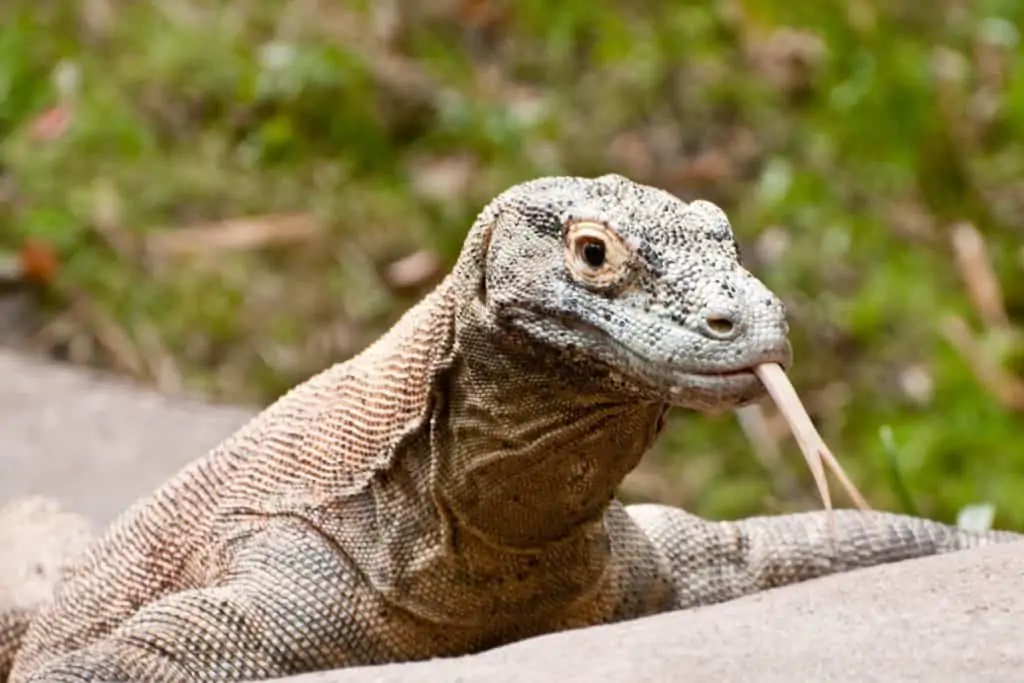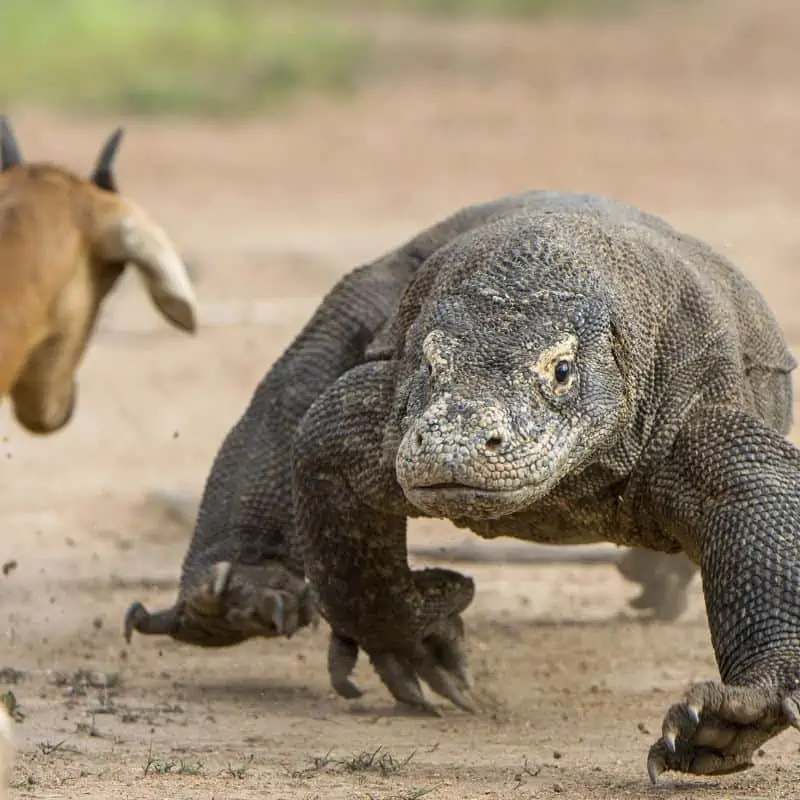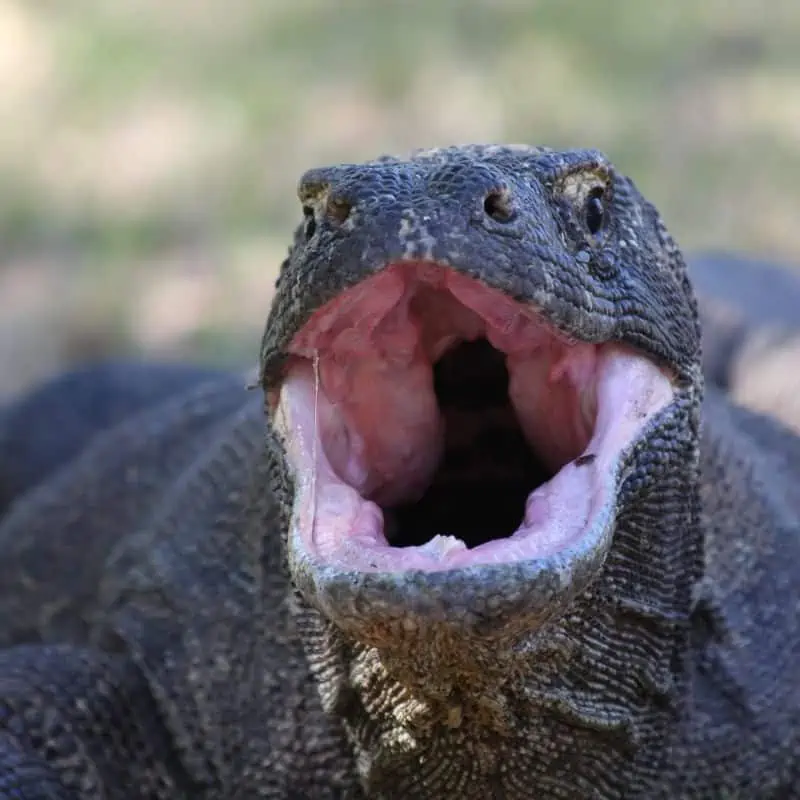Komodo dragons are fierce hunters that are difficult to tame. They are the largest and most vicious lizards on the planet. As these giant reptiles don’t possess the extremely powerful jaw of a crocodile, how do they kill their prey, and are Komodo Dragons poisonous?
Komodo dragons are venomous and inject venom into their bite to weaken and kill their prey. The combination of the toxic substance and the pain of the bite by the Komodo dragon kills the target. When infected with venom, animals can die within hours, whereas humans may last a day or two.
For a long time, Komodo Dragons have been misunderstood by humans; they weren’t known as venomous animals but rather thought to use bacteria in their mouths to kill prey.
In this article, we will clarify some misconceptions about the Komodo Dragon’s infamous bite.

Fact Check: It’s Venom, Not Bacteria
For years, the world thought that the Komodo dragons used bacteria in their saliva to attack their prey and kill them with these harmful microbes.
This idea was first introduced by an American biologist known as Walter Auffenberg.
Auffenberg discovered that large animals, such as water buffalo, would quickly get fatal diseases after being bitten by the Komodo dragons.
He hypothesized that the dragons use microorganisms as venom based solely on this observation without providing any supporting data.
This discovery took place at the back of a unique opportunity that Bryan Fry received. He examined two komodo dragons put down due to terminal illnesses in zoos.
Fry and colleagues took this time to research the biochemistry of the lizard’s venom.
They concluded that venom helped Komodo dragons kill their prey by using compounds that reduce blood pressure.

How Do Komodo Dragons Use Their Venom?
Like a snake bite, Komodo Dragons use their bite to project venom into their prey’s body.
The Komodo dragon’s venom delivery system is one of the most intricate and elaborate. The venom gland is not a trivial structure but a big bulge. They have numerous venom ducts between their teeth.
As a result of having multiple venom ducts, komodo dragons can’t poison as effectively as snakes.
The dragons use a unique bite-and-pull technique to seep toxins into wounds during a sustained, fierce attack instead of delivering venom immediately via a hard bite.
A Komodo dragon bite is close to a maximum force of 39 Newton (500 – 600 psi); compared with a similar-sized Saltwater crocodile’s bite of 252 Newton, it is extremely low.
This makes the venom an integral part of its predatory attacks.
The vicious bite delivers poison deep into the wound, putting the victim in a state of shock as the venom lowers blood pressure, triggers profuse bleeding, and hinders wound healing.
These processes render the victims helpless and unable to defend themselves. Some of the blood pressure-lowering substances in the venom are just as effective as those discovered in the world’s most venomous snake.
The exciting thing is that they let their prey leave once they’ve bitten them; little do the prey know that they haven’t escaped from death because the venom from the bite will kill them soon.
Later, the dragon will quickly locate the dying prey by following the strong scent of the toxin.
How Toxic Is a Komodo Dragon’s Venom?
Numerous poisonous chemicals, including those that impede blood coagulation and expand blood arteries, were discovered through genetic and chemical investigation.
If injected into an animal, these would likely cause shock via lowering blood pressure.
When injected with the assistance of razor-sharp teeth, this venom makes it one of the deadliest weapons to exist.
The venom of a Komodo dragon in a human body leads to drastic changes. The venom leads to coagulopathy, roughly understood as excessive bleeding, muscle spasm, and hypotension, also known as low blood pressure.
In the case of the Komodo dragon’s bite on a Los Angeles zookeeper, the victim’s wound healed without infectious complications. However, this only happened after extreme care was provided immediately to her.
However, she could still feel numbness and tingling in her right fifth finger even eight months after the bite.

What Makes The Venom So Toxic?
The saliva of a Komodo dragon contains a variety of peptides, each as venomous as the other.
Scientists have found natriuretic, kallikrein, crisp toxins, and type III phospholipase unique to lizards.
Combining all these peptides makes the venom of the Komodo dragon extraordinarily lethal and dangerous.
What Happens if a Komodo Dragon Bites You?
Usually, in the case of animals, the Komodo dragon’s venom sends the victim into shock; the rapid lowering of blood pressure and excessive blood loss leads to the victim dying.
A Komodo’s combination of venom and bacteria can kill an adult human without adequate care. Otherwise, the bacteria and the toxins make it highly unlikely for a human to survive.
Komodo dragons are vicious animals that attack and hunt whatever they want; as a result, they have also attacked humans in the past.
When bitten by a Komodo dragon, a human would feel their blood pressure lowering, and excessive blood loss will weaken the victim. Excessive blood loss is a result of coagulopathy.
In some recorded cases of Komodo dragon bites, the paramedics have used anesthesia for pain relief. They have also used Hydromorphone for pain relief and extensively cleaned the wound.
Final Thoughts On Komodo Dragon Venom
Nature has some fascinating creatures and exciting questions yet to be answered; luckily, whether a Komodo dragon is poisonous and how poisonous it is has been answered.
Komodo dragons venom is an exciting component of nature, and as scientists research it further, there is a chance for new antibiotics and inventions to form as a result.
If you are ever in the presence of a Komodo Dragon, it’s best to keep your distance and avoid the Komodo Dragon venom altogether.
FAQs
Are Komodo Dragons Immune To Their Venom?
Like king cobras, komodo dragons are not negatively affected by their venom. Researchers are trying to study the components protecting Komodo dragons from the poison in their mouths.
Is There A Cure For The Komodo Dragon Bite?
As with any venomous bite, the immediate cure is wound control, early response, and care. A delayed response in case of a bite can prove to be fatal. Unlike snake bites, humans don’t have a high death toll due to komodo dragon bites.
Can A Komodo Dragon Paralyze A Human?
Komodo dragon’s saliva is extremely dangerous as it contains venom that can seriously harm, if not kill, humans. Paralysis from animal bites is commonly seen at the site of the bite, only in the muscle affected. No paralysis has been reported in humans from a komodo dragon bite.
What Is Komodo Dragon Blood Used For?
Komodo dragon blood produces a strong synthetic compound that is a powerful antibiotic.

